
The United Arab Emirates is situated in the Middle East and southwest Asia, bordering the Gulf of Oman and the Persian Gulf, between Oman and Saudi Arabia; it is at a strategic location along the northern approaches to the Strait of Hormuz, a vital transit point for world crude oil. The UAE lies between 22°50′ and 26° north latitude and between 51° and 56°25′ east longitude. It shares a 19 km (12 mi) border with Qatar on the northwest, a 530 km (330 mi) border with Saudi Arabia on the west, south, and southeast, and a 450 km (280 mi) border with Oman on the southeast and northeast.

Ras Al Khaimah (RAK) is one of the seven emirates that make up the United Arab Emirates (UAE). The city of Ras Al Khaimah, abbreviated to RAK or RAK City, is the capital of the emirate and home to most of the emirate's residents. It is linked to the Islamic trading port of Julfar. Its name in English means "headland of the tent". The emirate borders Oman's exclave of Musandam, and occupies part of the same peninsula. It covers an area of 2,486 km2 (960 sq mi) and has 64 km (40 mi) of beach coastline. As of 2015, the emirate had a population of about 345,000.

The Musandam Peninsula, locally known as Ruus Al Jibal, is a peninsula that forms the North western point of the Arabian Peninsula. It is located to the south of the Strait of Hormuz between the Persian Gulf and Gulf of Oman. It is inhabited by the Shihuh tribe and is mainly governed by Oman as the Musandam Governorate with certain parts governed by the United Arab Emirates, including Ras Al Khaimah and parts of Dibba.
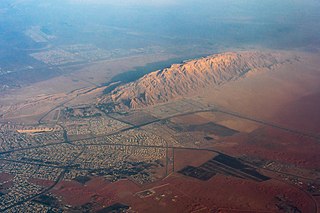
Jabal Hafeet is a mountain in the region of Tawam, on the border of the United Arab Emirates and Oman, which may be considered an outlier of the Hajar Mountains in Eastern Arabia. Due to its proximity to the main Hajar range, the mountain may be considered as being part of the Hajar range. To the north is the UAE city of Al Ain, in the Eastern Region of the Emirate of Abu Dhabi, and the adjacent Omani town of Al-Buraimi.
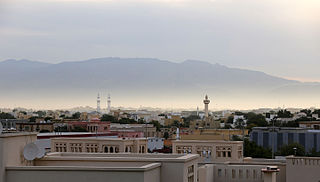
Jabal Al-Mebraḥ, also commonly mistakenly referred to by the name of the nearby peak Jabal Yibir, is a 1,505 m (4,938 ft) tall mountain in the United Arab Emirates (UAE).
Shimal is the name of a settlement in Ras Al Khaimah, United Arab Emirates. It is associated with the Shihuh tribe of the Northern UAE and Oman and with the foundation of the Islamic era port of Julfar, and was once the seat of the Ruler of Julfar. It is also the location of an important archaeological site dating back to the Umm Al Nar culture.
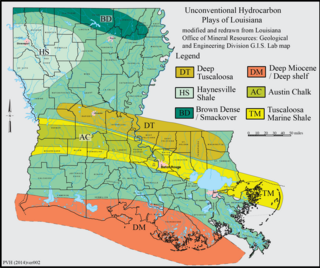
The Haynesville Shale is an informal, popular name for a Jurassic Period rock formation that underlies large parts of southwestern Arkansas, northwest Louisiana, and East Texas. It lies at depths of 10,500 to 13,000 feet below the land’s surface. It is part of a large rock formation which is known by geologists as the Haynesville Formation. The Haynesville Shale underlies an area of about 9,000 square miles and averages about 200 to 300 feet thick. The Haynesville Shale is overlain by sandstone of the Cotton Valley Group and underlain by limestone of the Smackover Formation.

Jebel Jais is a mountain of the North-Western Hajar range in the Musandam Governorate of Oman and also in Ras Al Khaimah, United Arab Emirates. The summit has an elevation of 1,934 m (6,345 ft). The summit is located on the Omani side, but a high point west of this peak is considered the highest point in the United Arab Emirates, at 1,892 m (6,207 ft) above sea level, and with around 10m of prominence. Since the summit is on the Omani side, Jabal ar Raḩraḩ, at 1,676 m (5,499 ft), is the highest peak in the UAE, with significant prominence.

The Hajar Mountains are the highest mountain range in the eastern part of the Arabian Peninsula, shared between northern Oman and eastern United Arab Emirates. Also known as "Oman Mountains", they separate the low coastal plain of Oman from the high desert plateau, and lie 50–100 km (31–62 mi) inland from the Gulf of Oman.
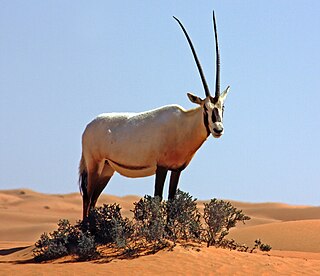
The wildlife of the United Arab Emirates is the flora and fauna of the country on the eastern side of the Arabian Peninsula and the southern end of the Persian Gulf. The country offers a variety of habitats for wildlife including the coast, offshore islands, mangrove areas, mudflats, salt pans, sand and gravel plains, sand dunes, mountain slopes, wadis and rocky summits. Because the terrain is so varied, it supports a greater number of species of plants and animals than might have been expected in this relatively small country.
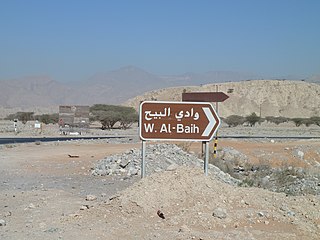
Wadi Bih, alternatively Wādī Al-Bayḥ, is a river/wadi that crosses the North-Western Hajar Mountains from the United Arab Emirates, and traversing Oman before returning to the UAE. From the West to the East, it originates in Ras Al Khaimah on the Gulf, before crossing the Omani exclave at the tip of the Musandam Peninsula, past the village of Zighi and into Fujairah at Dibba Al-Hisn, on the Gulf of Oman. The wadi is a popular location for birdwatchers.
The geology of Saudi Arabia includes Precambrian igneous and metamorphic basement rocks, exposed across much of the country. Thick sedimentary sequences from the Phanerozoic dominate much of the country's surface and host oil.
The United Arab Emirates (UAE) is a relatively new country – it was formed in 1971. However, the history of the land that the UAE occupies dates back to the Neolithic Age, which is evidenced by inscriptions, drawings and archaeological finds uncovered in the seven emirates during the period from the early 1950s to the present day.

Jabal ar Raḩraḩ is a peak in the Hajar Mountains, northeast of the United Arab Emirates, in the Emirate of Ras Al Khaimah. It has a height of 1,691 metres, and is situated entirely within the United Arab Emirates, at the coordinates 25.94419°N, 56.15219°E.
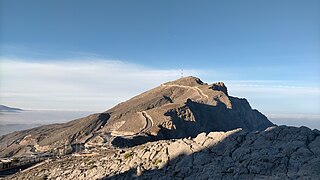
Jabal Raḩabah is a peak in the Hajar Mountains, northeast of the United Arab Emirates, in the Emirate of Ras Al Khaimah. At 1,543 m (5,062 ft), it is one of the highest peaks in the UAE, located entirely within the territory of the Emirates
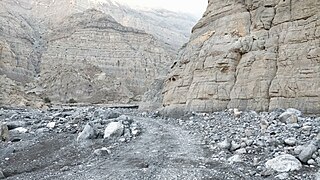
The Wadi Litibah is a valley or dry river, with intermittent flow, flowing almost exclusively during the rainy season, located northeast of the United Arab Emirates, in the Emirate of Ras al Khaimah.
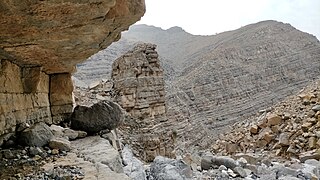
The Wadi Arus is a valley or dry river, with intermittent flow, which flows almost exclusively during the rainy season, belonging to the river basin of Wadi Bih, north-east of the United Arab Emirates (UAE), in the Emirate of Ras al Khaimah.


















